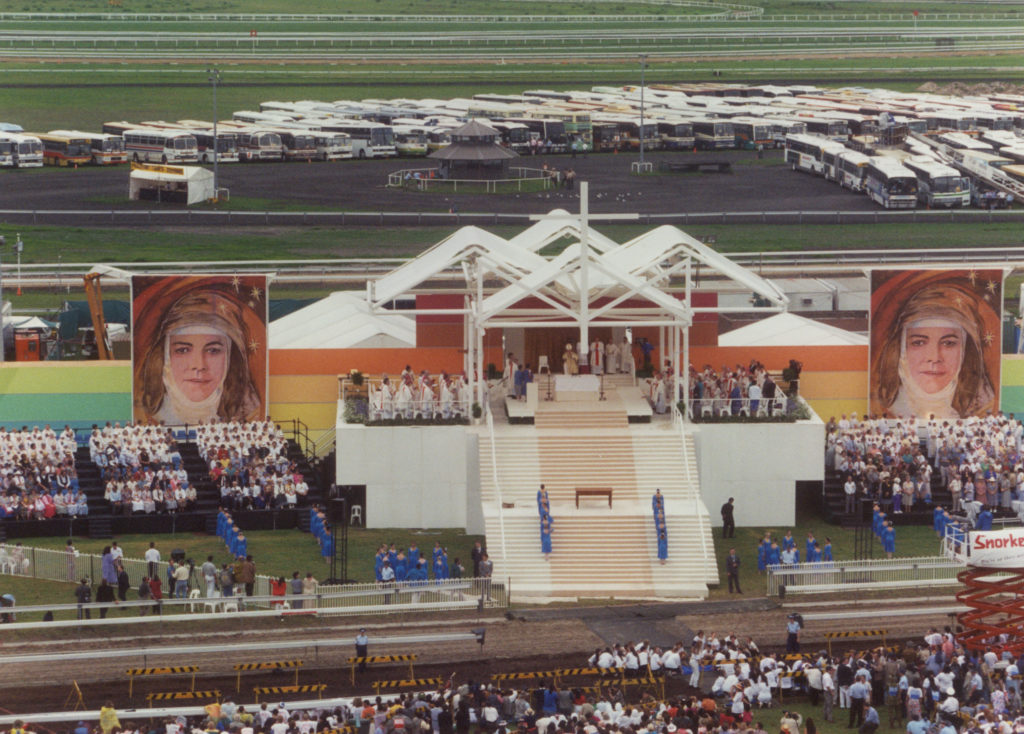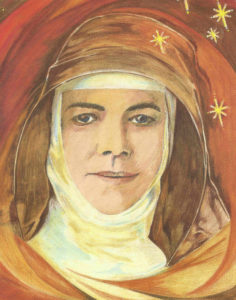
The Beatification of Mary MacKillop was a historical time for Australians. The naming of a saint born and raised in Australia brought great joy, not only to Catholics, but to many others who had come to know and admire her.
Weatherwise, 19 January 1995 was grey, threatening to rain. In contrast, the prevailing atmosphere was one of pure happiness. You felt it everywhere! This positive atmosphere had also been at the magnificent vigil-concert/display at the Sydney Domain the evening before.
Now, among those who filled St Mary’s Cathedral in Sydney to join Pope John Paul II in Morning Prayer, the joy was palpable. It spread to the thousands who lined the flagged and decorated streets enroute to the Mary MacKillop Memorial Chapel in North Sydney housing the tomb of Mary MacKillop, as the Pope prayed there and was greeted by schoolchildren from all parts of Australia. It accompanied the more than a quarter million pilgrims who poured onto the Randwick Racecourse for the Beatification Mass. People in shops, on the streets, on buses and trains smiled; strangers greeted each other. It seemed that all around there was a sense of pride that we were celebrating one of our own – one of ‘us’ – and we could rejoice.

What astounded many was the fact that the occasion was not just a church event. The government of the day, police, and other officials contributed their services to making it a state affair. The Prime Minister, the Premier and Heads of Departments represented the whole nation in greeting the Pope, joining ecumenical and inter-faith groups in the celebration of God’s work in the life of this Australian woman.
Panoramic photos taken from aircraft of the ceremony itself give us the ‘big-picture view’ of the Beatification. The vast arena of the Randwick Racecourse; the huge crowd; the dark blue ribbon of the Josephite emblem tattooed across the assembly; the immense centrepiece of the altar mounted on a platform of steps and flanked by the out-sized paintings of Mary MacKillop – these signified, as it were, the impact of a simple life on the whole land.
On the other hand, small snapshots speak of the power of individual impressions. The feeling of bondedness between Sisters wearing their brown, white and blue scarves; the significance of the reconciliation rite of the Mass being led by first-nations people in the smoking ceremony; the inclusion in the liturgy of ordinary people from all over Australia through symbol and participation – we were all one, all recognised, all playing our part to make up the whole.
Despite the enormous crowds, everything that day went smoothly. Perhaps some worried whether they would find their bus among the hundreds lined up; some would have struggled to see the screens bringing what was happening at the altar to view. But meticulous planning meant that the Beatification ceremony was one we remember with gratitude and pride. Memories are reinforced by mementos.
A homely touch to the magnificence of the day was given when people were offered a small plant, certified to go into every state of Australia, to remind them of God’s invitation to life. As one Sister said, we experienced on Mary’s Beatification Day ‘a little bit of heaven’.
Kathleen Dawe rsj and Mary Cresp rsj
